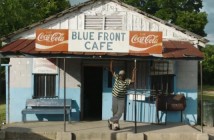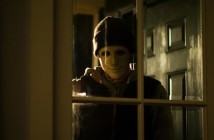
Editor’s Note: The following review is part of our coverage of TIFF’s winter film series Magic Motion: The Art of Stop-Motion Animation. For more information, visit tiff.net and follow TIFF on Twitter at @TIFF_NET.
With a railroad plot and the kind of emotionless acting that bad 1950s movies are known for, one wouldn’t expect much from Earth vs. the Flying Saucers (1956), a tiny little B-movie “weirdie,” as Variety called science fiction films at the time. Thanks to the stellar visuals from legendary special effects master Ray Harryhausen, however, Earth vs. the Flying Saucers made a hefty profit on release, and since has become one of the best known and best loved of all alien invasion films. The film has influenced directors from Edward D. Wood, Jr. to Roland Emmerich, seen its footage borrowed for a bizarre and backhanded insult in Orson Welles’ F For Fake (1973), and inspired Crow T. Robot’s seminal but unpublished masterpiece Earth vs. Soup (1991).
The flying saucers look fantastic with their simple and understated design, Harryhausen’s stop-motion work giving them a smooth flight.
Dr. Russell Marvin (Hugh Marlowe), scientist in charge of a satellite program known as Operation Skyhook, is dictating notes into a tape recorder as his secretary Carol (Joan Taylor) speeds back to the super secret military lab. Carol is not just Dr. Marvin’s secretary, she’s now his wife, and the two plan on spending their honeymoon working rather than relaxing. Dr. Marvin has lost contact with all of the satellites launched to date, and soon discovers why: someone or something is shooting the satellites out of their orbits.
Complicating things is a rash of UFO sightings in the Washington, D.C. area. Russell and Carol also saw a UFO as they were driving back from their quickie wedding, though almost immediately decided that the flying saucer was a hallucination. But not so fast: the sound of the saucer was captured on Dr. Marvin’s tape recorder! The couple decide to spend their honeymoon not just working, but locked in a soundproof lab, monitoring the final satellite launch.
 Earth vs. the Flying Saucers was based on a real-world event known as the “Washington Flap.” For most of the month of July in 1952, bright, unidentifiable lights hovered over the nation’s capitol, alarming pilots in the air and civilians on the ground. The nation was captivated by the continuous stories of what many local newspapers called “flying saucers” — often in 48-point sans serif and accompanied by doctored photos — and by the end of the month, the Armed Forces issued a standing order to shoot down any unidentified objects encountered.
Earth vs. the Flying Saucers was based on a real-world event known as the “Washington Flap.” For most of the month of July in 1952, bright, unidentifiable lights hovered over the nation’s capitol, alarming pilots in the air and civilians on the ground. The nation was captivated by the continuous stories of what many local newspapers called “flying saucers” — often in 48-point sans serif and accompanied by doctored photos — and by the end of the month, the Armed Forces issued a standing order to shoot down any unidentified objects encountered.
Earth vs. the Flying Saucers pretends to be a reenactment of those events, and as far as the broad strokes are concerned, gets the details mostly right. The crystal clear views of the alien ships turn this story into a what-if rather than a documentary, of course; the UFOs sighted in 1952 were vague balls of light later dismissed as weather phenomena.
Earth vs. the Flying Saucers laughs at your puny attempts to uncover deeper meaning in its terse dialogue and railroad plot.
The UFOs that inhabit the skies of Earth vs. the Flying Saucers are not just quivering lights in the sky but unambiguously airborne ships from another world. Dr. Marvin and his wife Carol seem less convinced, despite having been so close to the UFO that flew past their two-ton sedan they could have reached out and touched it. Their reaction doesn’t make much sense, but the logic behind it, if one pardons such a loose definition of the word “logic,” surely involved the film trying to wring some tension out of the superfluous opening scenes.
Once it’s established that the ships and their alien pilots are real, the movie finally gets going. Seconds after a ship lands and an alien lumbers toward a military building, the United States Army kills the creature for no reason other than, by god, that is what we did in America in the 1950s: destroy anything that’s a little different and kinda scary. Alien-Earthling relations continue to decline, and soon the entire world is on notice: surrender peacefully so the aliens can take the planet as their own, or be massacred by the aliens who will take the planet anyway. It all leads to a spectacular soldiers-versus-saucers finale set in Washington, D.C., one of the unquestionable cinematic highlights of 1950s science fiction films.
Harryhausen’s stop-motion saucer footage was completed before the script was finished, and it shows. The saucers look fantastic with their simple and understated design, and Harryhausen’s stop-motion work giving them a smooth flight. Harryhausen also used stock footage, matte techniques and rear projection to great effect. To modern audiences these tricks will look dated, but in comparison to other films of the era, including A-list films, Earth vs. the Flying Saucers is terribly well done.
The problem is that the way the saucers (and the aliens controlling them) behave makes no sense. Harryhausen said in interviews that he had wanted the look of the saucers to evoke an intelligence behind them, and he certainly achieved this, but the ludicrous script undermines much of his work. The film is just a flimsy framework for the finale, the still-astonishing destruction of Washington, D.C. It’s so flimsy, in fact, that much of the film, from the empty halls of what should be a buzzing Pentagon, to the curious fact that Carol spends much of the film sleeping, turns into camp.
It’s interesting that the aliens attack soldiers, usually (but not always) after being attacked first, yet steadfastly refuse to attack civilians, only killing a few by accident after one of their ships is shot down. These civilians are hilarious, by the way, always seen in large groups and always panicking; Earth vs. the Flying Saucers has little use for the general populace. The same goes for our most famous government buildings and monuments, most of which are destroyed, and all of which would have been spared had the United States Armed Forces not shot the saucers out of the air.
Don’t try too hard to turn all that into some kind of metaphor, though. Earth vs. the Flying Saucers laughs at your puny attempts to uncover deeper meaning in its terse dialogue and railroad plot. Sure, with the destruction of the White House, Washington Monument and the Capitol dome, one could argue that the film is reaffirming that America is stronger than the sum of its most treasured patriotic monuments, but it’s far more likely that the filmmakers simply wanted a showcase for the film’s special effects.
Still, Earth vs. the Flying Saucers is a fine showcase for Harryhausen’s talents, even if he does achieve more spectacular effects later on in his career. Simple as they are, the saucers in this film are fun to watch, even pleasant, but perhaps pleasant isn’t what a film should be going for when it’s depicting world-destroying aliens. But for fans of 1950s science fiction and stop-motion animation, Earth vs. the Flying Saucers is a must-see, a wholly fun viewing experience, especially with a crowd.
Earth vs. the Flying Saucers is a must-see for all film fans. It's fun, it's campy, and it ends with one of the best evil alien invader battles to make it out of the 1950s Cold War science fiction craze, courtesy the legendary stop-motion pioneer Ray Harryhausen.



